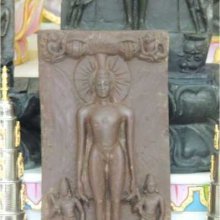Vasupujya, Vasupūjya, Vāsupūjya: 9 definitions
Introduction:
Vasupujya means something in Jainism, Prakrit, Hinduism, Sanskrit. If you want to know the exact meaning, history, etymology or English translation of this term then check out the descriptions on this page. Add your comment or reference to a book if you want to contribute to this summary article.
Vasupujya has 8 English definitions available.
Images (photo gallery)
Languages of India and abroad
Sanskrit dictionary
[Deutsch Wörterbuch]
Source: Cologne Digital Sanskrit Dictionaries: Böhtlingk and Roth Grosses Petersburger WörterbuchVāsupūjya (वासुपूज्य):—m. bei den Jaina Nomen proprium des [12ten] Arhant's der gegenwärtigen Avasarpiṇī, eines Sohnes des Vasupūjyarāj, [Hemacandra’s Abhidhānacintāmaṇi 27.]
Sanskrit, also spelled संस्कृतम् (saṃskṛtam), is an ancient language of India commonly seen as the grandmother of the Indo-European language family (even English!). Closely allied with Prakrit and Pali, Sanskrit is more exhaustive in both grammar and terms and has the most extensive collection of literature in the world, greatly surpassing its sister-languages Greek and Latin.
See also (Relevant definitions)
Starts with: Vasupujyanatha, Vasupujyaraj.
Full-text (+74): Campapuri, Jaya, Jayavati, Kumara, Toshala, Trivana, Vanayuja, Mallavarta, Pundra, Pragjyotisha, Mudgara, Nepala, Mula, Utkala, Tamralipta, Brahmottara, Murala, Kaishika, Kamboja, Vokkana.
Relevant text
Search found 6 books and stories containing Vasupujya, Vasupūjya, Vāsupūjya, Vasu-pujya, Vāsu-pūjya; (plurals include: Vasupujyas, Vasupūjyas, Vāsupūjyas, pujyas, pūjyas). You can also click to the full overview containing English textual excerpts. Below are direct links for the most relevant articles:
Trishashti Shalaka Purusha Caritra (by Helen M. Johnson)
Part 6: Vāsupūjya’s childhood < [Chapter II - Vāsupūjyacaritra]
Part 3: Vāsupūjya’s parents (king Vasupūjya and queen Jayā) < [Chapter II - Vāsupūjyacaritra]
Part 7: Refusal to marry < [Chapter II - Vāsupūjyacaritra]
Jain Remains of Ancient Bengal (by Shubha Majumder)
Images of Tīrthaṅkara Vāsupūjya < [Chapter 6 - Iconographic Study of Jaina Sculptural Remains]
The twenty-four Tīrthaṅkaras and their Yakṣas and Yakṣiṇīs < [Chapter 6 - Iconographic Study of Jaina Sculptural Remains]
Meaning of Tīrthaṅkara < [Chapter 1 - Introduction and Scope of the Present Study]
Bhagavati-sutra (Viyaha-pannatti) (by K. C. Lalwani)
Part 3 - On patriarchs < [Chapter 5]
Kalpa-sutra (Lives of the Jinas) (by Hermann Jacobi)
Jainism in Odisha (Orissa) (by Ashis Ranjan Sahoo)
Adinatha Temple, main temple (Khordha) < [Chapter 3: Survey of Jaina Antiquities in Odisha]
Jaina Antiquities at Khandagiri Hills (Khordha) < [Chapter 3: Survey of Jaina Antiquities in Odisha]
Jaina Sculptures at Achutrajpur < [Chapter 3: Survey of Jaina Antiquities in Odisha]
A study of the philosophy of Jainism (by Deepa Baruah)
Chapter I.c - The lives of the Tīrthaṅkaras < [Chapter I - Introduction]


